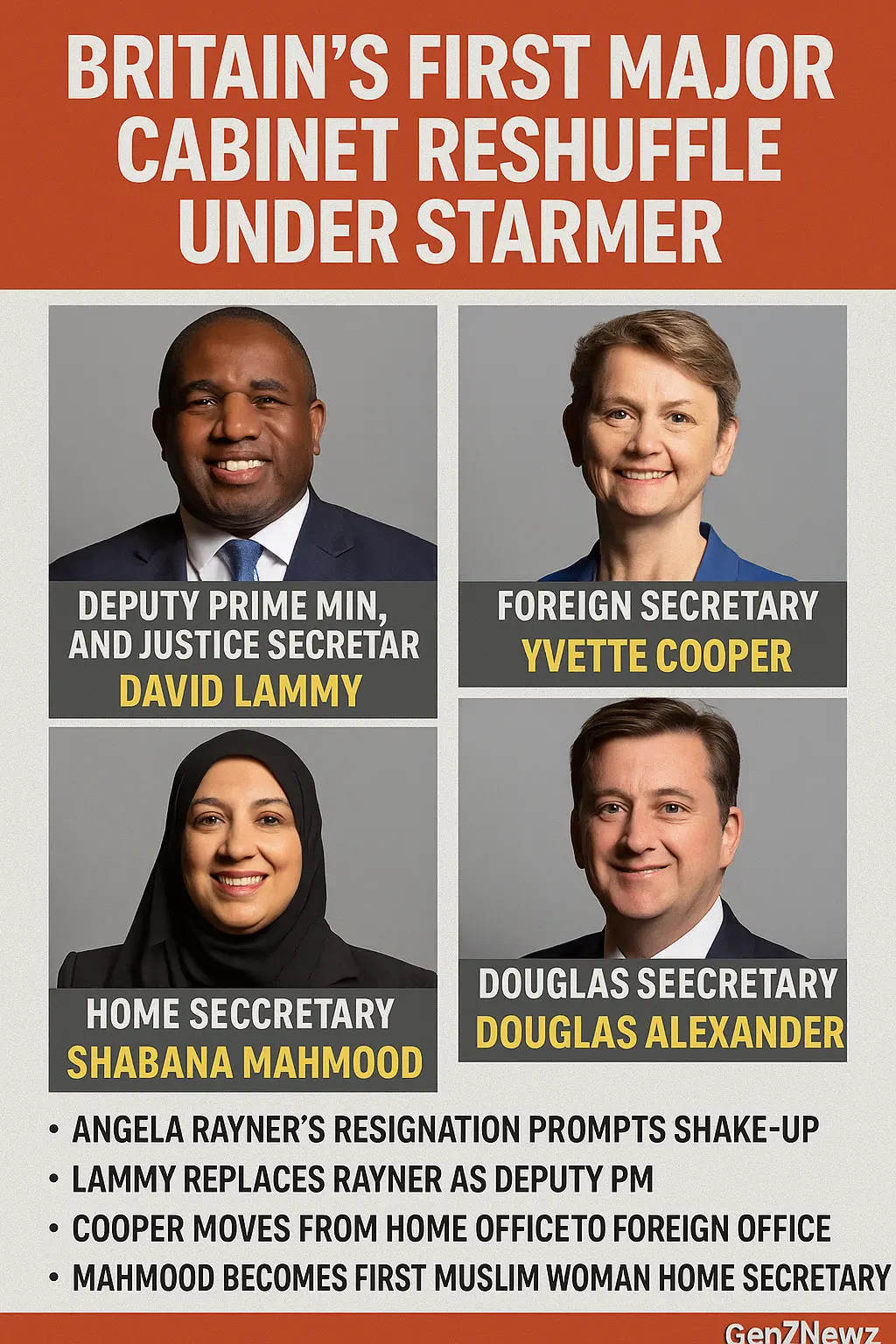
⚡️ Why This Shake-Up Happened
In September 2025, Prime Minister Keir Starmer carried out his first major cabinet reshuffle since becoming PM—triggered by the sudden resignation of Deputy Prime Minister Angela Rayner, who stepped down after a tax and stamp duty scandal. politicsuk.com+3Wikipedia+3PBS+3
The move was dramatic, fast, and framed by Downing Street as the start of “phase two” of Starmer’s government—a push to reset his administration and refocus on delivery. Wikipedia+2Institute for Government+2
🔄 Who Moved, Who Got Promoted, and Who Was Let Go
| What Happened | Who’s In | Who’s Out or Demoted |
|---|---|---|
| Deputy PM & Justice | David Lammy moves from Foreign Secretary to become Deputy Prime Minister and Justice Secretary PBS+2Sky News+2 | Angela Rayner resigns from both roles and returns to the backbenches Wikipedia+2PBS+2 |
| Foreign Secretary | Yvette Cooper moves from Home Office to Foreign Office PBS+2politicsuk.com+2 | Yvette Cooper’s old Home Secretary role is vacated; others depart from Home Office Sky News+1 |
| Home Secretary | Shabana Mahmood takes over Home Office, becoming the first Muslim woman to fill the role Institute for Government+3Sky News+3politicsuk.com+3 | Several figures including Yvette Cooper, Angela Eagle, and Diana Johnson left or were reshuffled away from Home Office posts Wikipedia+2Sky News+2 |
| Scotland Secretary | Douglas Alexander is reappointed as Secretary of State for Scotland Wikipedia+2Sky News+2 | Ian Murray loses his Scotland post and is shifted to a junior role in the Department for Culture, Media and Sport—sparking public outcry. Wikipedia+1 |
| Policy & Skills | Pat McFadden gets a new “super ministry” combining work, pensions, and skills portfolios politicsuk.com+1 | Education Secretary Bridget Phillipson has her skills brief removed—seen by some as a downgrade. politicsuk.com |
Notably, Chancellor Rachel Reeves remained in place—a signal of continuity amid the broader shake-up. Institute for Government+2Wikipedia+2
Starmer also managed to achieve something historic: for the first time, the three top “Great Offices of State” below the PM—the Treasury, Foreign Office, and Home Office—are all held by women simultaneously. Institute for Government+2politicsuk.com+2
📉 Political Fallout, Reactions & Risks
The reshuffle drew sharp criticism from within Labour, especially from MPs who feel northern female ministers were disproportionately targeted. Wikipedia+1
Some observers view Starmer’s reshuffle as a swing to the right—arguing that the changes deepen internal divisions rather than heal them. Institute for Government+1
Critics warned the reshuffle might be reactive rather than strategic, driven more by crisis management than long-term planning. Others say Rayner’s exit was a strategic reset to reassert Starmer’s leadership. Wikipedia+2Bloomberg.com+2
The Ian Murray demotion was particularly controversial. Many saw it as a blow against Labour’s Scottish wing—and a demotion that could cost the party credibility in Scotland. Wikipedia+2Sky News+2
🧠 What This Means for Gen Z & Voters
Labour’s message is changing. By reshuffling now, Starmer seems to be signaling a shift from “on-yourside” rhetoric to “getting things done” — a move meant to appeal to voters frustrated by perceived inaction or drama. Institute for Government+1
Diversity gains, but with trade-offs. The triple-female leadership lineup is being hailed as a symbolic milestone—but many of the female figures who’ve been removed or shuffled were also strong voices for working-class or regional Labour, raising questions about what kind of female representation is being prioritized. Institute for Government+1
The Labour Party’s internal tensions are exposed. This reshuffle makes clear that Starmer’s government is still navigating a precarious balance between soft-left ideals and a centrist, managerial Labour approach. That tension could reshape Labour’s policies on immigration, public services, and economic reform. Wikipedia+2Institute for Government+2
Gen Z activists should watch deputy leadership changes. With Rayner gone and a deputy leadership contest looming, Labour’s internal direction—including on youth, social justice, and climate issues—could be up for grabs. Wikipedia+1
✅ Bottom Line
Keir Starmer’s cabinet reshuffle is more than a typical “shake-up.” It’s a strategic pivot—forced by crisis, yes, but also framed as the start of a new phase of governance. Whether it succeeds in turning the tide for Labour depends on whether the new team can deliver on big promises, stay united, and avoid being overshadowed by controversy.
For Gen Z, the reshuffle offers a lens into how modern political teams evolve, and a real-world example of how gender, geography, party identity, and policy priorities collide inside government.

Leave a comment
Your email address will not be published. Required fields are marked *